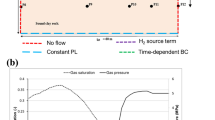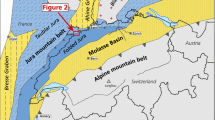Abstract
The work presented in this article is a part of the international European Commission FORGE project which studied the behaviour of repository gases in the context of radioactive waste disposal. Experimental work is essential to understand the main transport mechanisms for gas and to determine the main geophysical parameters. However, while laboratory and rock experiments can help to investigate the short- and partly the middle-term behaviour of gas in a rock formation, long-term predictions have to be based on numerical simulations. Numerical simulation of long-term gas behaviour in a deep geological repository was one of the aims in the FORGE project. The objectives of the FORGE modelling were to describe the state-of-the-art consideration of gas in performance assessment, and to propose an updated treatment of gas issues in long-term safety assessments for high-level radioactive waste and spent nuclear fuel. Three benchmark exercises for a hypothetical geological repository in clay host rock ranging in scale from a single disposal cell to the whole repository were defined. To provide added value to this benchmark, a feature not yet well represented in typical gas simulations was introduced: the explicit representation of the interfaces between the excavation disturbed zone and the engineered elements within the excavation, such as waste canisters, bentonite plugs, and access drifts. In order to assess gas transport behaviour at the whole repository scale, models were developed with ‘mathematical’ or ‘numerical’ upscaling techniques for small-scale features. The assessment across different modelling scales revealed the main long-term gas migration pathways and led to the conclusion that the explicit representation of interfaces is not important.

(modified from Wendling et al. 2013a)

(modified from Wendling et al. 2013a)




(modified from Wendling et al. 2013b)

(modified from Wendling et al. 2013b)



(modified from Wendling et al. 2013c)




Similar content being viewed by others
References
Ahusborde E, Amaziane B, Jurak M (2015) Three-dimensional numerical simulation by upscaling of gas migration through engineered and geological barriers for a deep repository for radioactive waste. In: Shaw RP (ed) Gas generation and migration in deep geological radioactive waste repositories, special publications, 415. Geological Society, London, pp 123–141
Amaziane B, Jurak M (2008) A new formulation of immiscible compressible two-phase flow in porous media. CR Mecanique 336(7):600–605
Amaziane B, El Ossmani M, Jurak M (2012) Numerical simulation of gas migration through engineered and geological barriers for a deep repository for radioactive waste. Comput Visual Sci 15(1):3–20
Bond AE, Benbow SJ (2009) QPAC multi-phase flow module functional specification and architectural design. Quintessa, Warrington
Bond AE, Thatcher KE, Norris S (2015) Multi-scale gas transport modelling for the EC FORGE project. Mineral Mag 79(6):1251–1263
Brommundt J, Kaempfer ThU, Enssle CP, Mayer G, Wendling J (2014) Full-scale 3D modelling of a nuclear waste repository in the Callovo-Oxfordian clay. Part 1: thermo-hydraulic two-phase transport of water and hydrogen. In: Norris et al (eds) Clays in natural and engineered barriers for radioactive waste confinement, special publications, 400. Geological Society, London, pp 443–467
Calder N (2014) FORGE benchmark modelling: cell, module and repository scale gas migration in a hypothetical repository. Nuclear Waste Management Organization NWMO, Toronto
Calder N, Avis J, Humphreys P, King F, Suckling P, Walsh R (2009) Postclosure safety assessment (V1): gas modelling. Nuclear Waste Management Organization NWMO, Toronto
Croisé J, Mayer G, Talandier J, Wendling J (2011) Impact of water consumption and saturation-dependent corrosion rate on hydrogen generation and migration from an intermediate-level radioactive waste repository. Transp Porous Med 90(1):59–75
Cuss RJ, Harrington JF, Noy DJ, Graham CC, Sellin P (2014) Evidence of localised gas propagation pathways in a field-scale bentonite engineered barrier system; results from three gas injection tests in the large scale gas injection test (Lasgit). Appl Clay Sci 102:81–92
Dagher EE, Nguyen TS, Infante Sedano JA (2018) Development of a mathematical model for gas migration (two-phase flow) in natural and engineered barriers for radioactive waste disposal. In: Norris et al (eds) Multiple roles of clays in radioactive waste confinement. Geological Society, London, Special Publications, 482. https://doi.org/10.1144/SP482.14
Dymitrowska M, Smai F, Bourgeat A (2015) Thermodynamic modelling of hydrogen migration in argillite for a deep geological radioactive waste repository: IRSN contribution to FORGE. In: Shaw RP (ed) Gas generation and migration in deep geological radioactive waste repositories, special publications, 415. Geological Society, London, pp 167–188
Enssle CP, Brommundt J, Kaempfer ThU, Mayer G, Wendling J (2014) Full-scale 3D modelling of a nuclear waste repository in the Callovo-Oxfordian clay. Part 2: thermo-hydraulic two-phase transport of water, hydrogen, 14C and 129I. In: Norris et al (eds) Clays in natural and engineered barriers for radioactive waste confinement, special publications, 400. Geological Society, London, pp 469–481
Fall M, Nasir O, Nguyen TS (2014) A coupled hydro-mechanical model for simulation of gas migration in host sedimentary rocks for nuclear waste repositories. Eng Geol 176:24–44
Flemisch B et al (2011) DuMux: DUNE for multi-{phase, component, scale, physics, … flow and transport in porous media. Adv Water Resour 34(9):1102–1112
Harrington JF, Graham CC, Cuss RJ, Norris S (2017) Gas network development in a precompacted bentonite experiment: evidence of generation and evolution. Appl Clay Sci 147:80–89
Justinavicius D, Poskas P (2015) Temperature and tortuosity effect on gas migration in a high-level waste disposal tunnel. Mineral Mag 79(6):1317–1325
Justinavicius D, Narkuniene A, Poskas P (2012) Impact of different factors on gas migration in the disposal cell of conceptual geological repository for high level radioactive waste. MECHANIKA 18:650–656
Justinavicius D, Poskas P, Narkuniene A (2016) Gas migration modelling in geological repository module in clay formation and sensitivity analysis. Eng Geol 213:158–168
Liu J, Wu Y, Cai CZ et al (2018) Investigation into water retention and gas permeability of Opalinus clay. Environ Earth Sci 77(5):213
Marschall P, Horseman S, Gimmi T (2005) Characterisation of gas transport properties of the Opalinus clay, a potential host rock formation for radioactive waste disposal. Oil Gas Sci Technol 60(1):121–139
Mikelič A (2009) An existence result for the equations describing a gas–liquid two-phase flow. CR Mecanique 337(4):226–232
Necib S, Diomidis N, Keech P et al (2017) Corrosion of carbon steel in clay environments relevant to radioactive waste geological disposals, Mont Terri rock laboratory (Switzerland). Swiss J Geosci 110:329–342
Norris S (2015) EC FORGE project: updated consideration of gas generation and migration in the safety case. In: Shaw RP (ed) Gas generation and migration in deep geological radioactive waste repositories, special publications, 415. Geological Society, London, pp 241–258
Norris S et al (2013) Synthesis Report: Updated Treatment of Gas Generation and Migration in the Safety Case. FORGE Report D1.5, European Commission
Nuclear Decommissioning Authority (NDA) (2010) Geological disposal, Gas status report. NDA, Didcot
O’Brien KE, Rainham D, O’Beirne-Ryan AM (2014) Using field analogue soil column experiments to quantify radon-222 gas migration and transport through soils and bedrock of Halifax, Nova Scotia, Canada. Environ Earth Sci 72:2607–2620
Oladyshkin S, Panfilov M (2011) Hydrogen penetration in water through porous medium: application to a radioactive waste storage site. Environ Earth Sci 64:989–999
Ortiz L, Volckaert G, Mallants D (2002) Gas generation and migration in Boom Clay, a potential host rock formation for nuclear waste storage. Eng Geol 64:287–296
Perko J, Weetjens E (2011) Thermohydraulic analysis of gas generation in a disposal facility for vitrified high-level radioactive waste in boom clay. Nucl Technol 174(3):401–410
Poller A, Enssle CP, Mayer G, Croise J, Wendling J (2011) Repository-scale modeling of the long-term hydraulic perturbation induced by gas and heat generation in a geological repository for high- and intermediate-level radioactive waste: methodology and example of application. Trans Porous Med 90(1):77–94
Pruess K, Oldenburg C, Moridis G (1999) TOUGH2 Users’s guide, v2.0. Earth Sciences Division, Lawrence Berkeley National Laboratory, University of California
Quintessa and Geofirma (2011) Gas generation and transport code T2GGM, v2. Quintessa and Geofirma, Toronto
Rodwell W et al (1999) Gas migration and two-phase flow through engineered and geological barriers for a deep repository for radioactive waste. EC/NEA Status Report, European Commission
Rodwell W, Norris S et al (2003) A thematic network on gas issues in safety assessment of deep repositories for radioactive waste (GASNET). Final Report on the Treatment in Safety Assessments of Issues Arising from Gas Generation, European Commission
Schaedle P, Kaempfer T, Pepin G, Wendling J, Brommundt J (2016) Combining high-resolution two-phase with simplified single-phase simulations in order to optimize the performance of PA/SA simulations for a deep geological repository for radioactive waste. In: Norris et al (eds) Clays in natural and engineered barriers for radioactive waste confinement, special publications, 443. Geological Society, London, pp 225–234
Senger R, Romero E, Ferrari A, Marschall P (2014) Characterization of gas flow through low-permeability claystone: Laboratory and two-phase flow analyses. In: Norris et al (eds) Clays in natural and engineered barriers for radioactive waste confinement, special publications, 400. Geological Society, London, pp 531–543
Senger R, Romero E, Marschall P (2018) Modeling of gas migration through low-permeability clay rock using information on pressure and deformation from fast air injection tests. Transp Porous Med 123(3):563–579
Sentis ML (2014) Two-phase flow modeling with TOUGH2-mp of a deep geological repository within the first benchmark of the FORGE project. Nucl Technol 187(2):117–130
Sentis ML, Gable CW (2017) Coupling LaGrit unstructured mesh generation and model setup with TOUGH2 flow and transport: a case study. Comput Geosci 108:42–49
Shaw RP (2015) The fate of repository gases (FORGE) project. In: Shaw RP (ed) Gas generation and migration in deep geological radioactive waste repositories, special publications, 415. Geological Society, London, pp 1–7
Smai F (2009) A model of multiphase flow and transport in porous media applied to gas migration in underground nuclear waste repository. CR Mecanique 347(9–10):527–532
Talandier J (2007a) Couplex-Gaz Benchmark. Synthesis of results for case 1. http://www.andra.fr/couplex/couplex_andra2.pdf. Accessed 17 Jan 2019
Talandier J (2007b) Couplex-Gaz Benchmark. Case 2. 3D modelling of a disposal area for vitrified waste. http://www.andra.fr/couplex/couplex_andra5.pdf. Accessed 17 Jan 2019
Thunderhead Engineering (2010) PetraSim User Manual, v5.0. Thunderhead engineering, Manhattan
Treille E, Wendling J, Trenty L, Loth L, Pepin G, Plas F (2012) Probabilistic analysis based on simulations of the long-term gas migration at repository-scale in a geological repository for high- and intermediate-level radioactive waste disposal in a deep clay formation. In: Proceedings TOUGH Symposium 2012, Lawrence Berkeley National Laboratory, California
Wendling J et al (2013a) Final report on benchmark studies on repository-scale numerical simulations of gas migration, Part 1: cell scale benchmark. FORGE Report D1.6, European Commission
Wendling J et al (2013b) Final report on benchmark studies on repository-scale numerical simulations of gas migration, Part 2: module scale benchmark. FORGE Report D1.6, European Commission
Wendling J et al (2013c) Final report on benchmark studies on repository-scale numerical simulations of gas migration, Part 3: repository scale benchmark. FORGE Report D1.6, European Commission
Xu T, Senger R, Finsterle S (2008) Corrosion-induced gas generation in a nuclear waste repository: reactive geochemistry and multiphase flow effects. Appl Geochem 23:3423–3433
Xu W, Shao H, Marschall P, Hesser J, Kolditz O (2013) Analysis of flow path around the sealing section HG—a experiment in the Mont Terri rock laboratory. Environ Earth Sci 70:3363–3380
Yu L, Weetjens E, Perko J, Mallants D (2011) Comparison of numerical tools through thermo-hydro-gas transport modeling for a geological repository in boom clay. Nucl Technol 174(3):411–423
Zhang K, Wu YS, Pruess K (2008) User’s Guide for TOUGH2-MP—a massively parallel version of the TOUGH2 code. Earth Sciences Division, Lawrence Berkeley National Laboratory, University of California
Zhang K, Croise J, Mayer G (2011) Computation of the Couplex-Gaz exercise with TOUGH2-MP: hydrogen flow and transport in the pore water of a low-permeability clay rock hosting a nuclear waste repository. Nucl Technol 174(3):364–374
Acknowledgements
The research leading to these results has received funding from the European Atomic Energy Community’s Seventh Framework Program (FP7/2009–2013) under Grant Agreement no. 230357, the FORGE project.
Author information
Authors and Affiliations
Corresponding author
Additional information
Publisher’s Note
Springer Nature remains neutral with regard to jurisdictional claims in published maps and institutional affiliations.
Rights and permissions
About this article
Cite this article
Wendling, J., Justinavicius, D., Sentis, M. et al. Gas transport modelling at different spatial scales of a geological repository in clay host rock. Environ Earth Sci 78, 221 (2019). https://doi.org/10.1007/s12665-019-8230-3
Received:
Accepted:
Published:
DOI: https://doi.org/10.1007/s12665-019-8230-3




